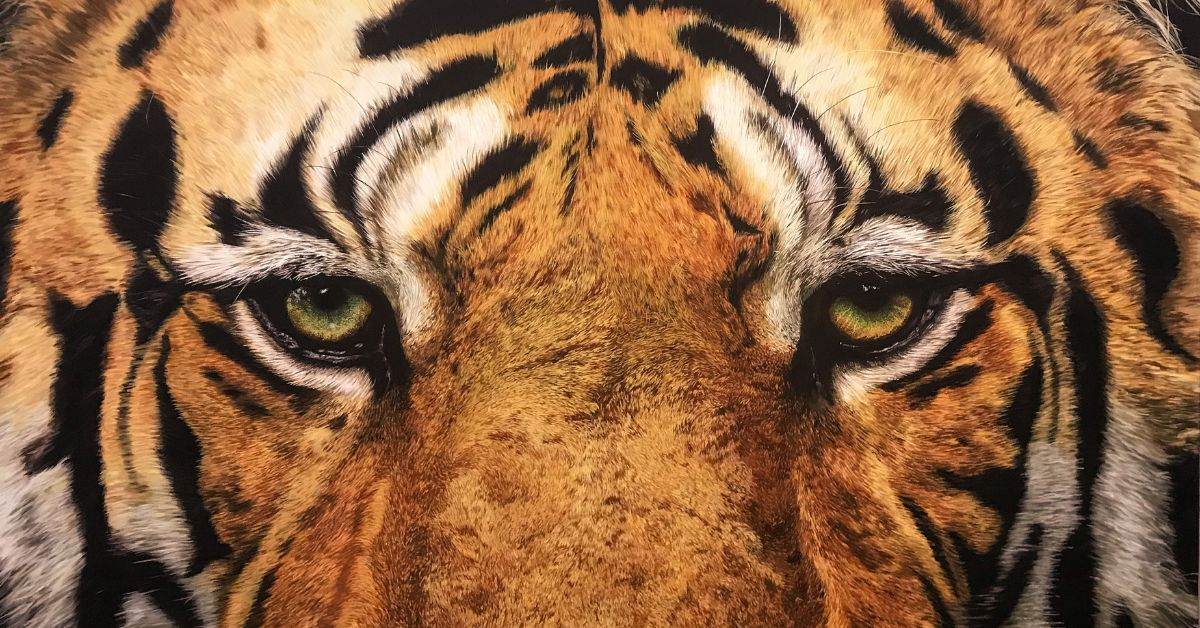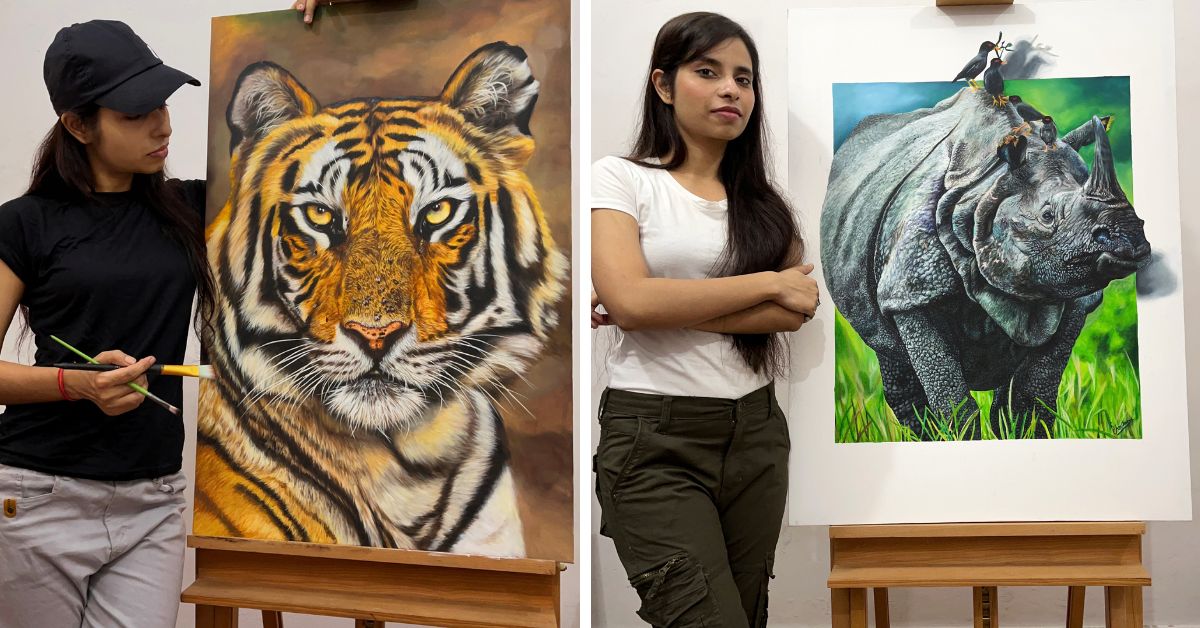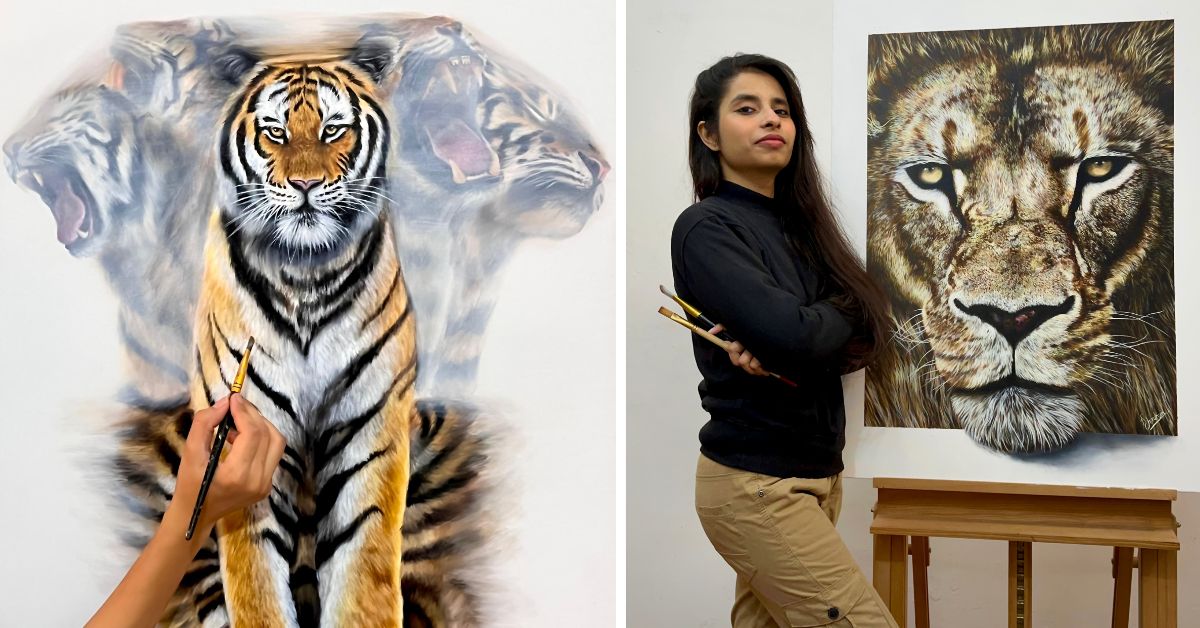“I don’t have to be a millionaire to help animals or people. A thought is what matters.” This simple yet powerful realisation set 29-year-old Deeksha Chauhan on a path where art became a voice for the unheard. As a self-taught wildlife artist, she breathes life into animals through realism and hyper-realism, compelling people to see, feel, and empathise.
Through her work, she hopes to challenge the way humans interact with wildlife, making conservation a conversation that can no longer be ignored.
Deeksha’s journey with art began early, nurtured by her mother, who introduced her to various creative forms. “My mother taught me musical instruments like the tabla and harmonium when I was a kid,” she recalls. While she enjoyed dance and music, painting always drew her in the most.
Even in school, where lectures demanded focus, her mind often wandered to sketches that often took shape on the last pages of her notebooks. “Throughout my school and college life, I often used to doodle and scribble something on the back of my notebook, especially in math classes,” Deeksha smiles.
Amidst career jumps, art remained constant
Though art was her true calling, her parents had a different vision for her future — an engineering degree at Vidya College, Meerut — and Deeksha pursued it. However, art never left her side. “I used to engage in art to pass time,” she adds.
She completed her degree in 2016 and entered the corporate world. After trying various roles in HR, sales, and business analysis, none of them held her interest for long. “Whatever job I took up, I couldn’t stay there for more than three weeks.” The rigid structures of corporate life crushed her creativity, making it clear that she was searching for something deeper.
Deeksha’s curiosity led her towards research, preparing for exams in chemistry and neuroscience. She even pursued a Python course, hoping to find fulfilment in machine learning. But time and again, she felt like she was going through the motions rather than truly engaging with what fascinated her.

“I wanted to learn the process, but it was more exam-oriented.” The same frustration came up when she enrolled in an art certification course in 2019. “There too, it was all about passing the exams rather than understanding the concepts for innovative applications.”
The pressure of conforming to traditional career expectations weighed on her, but no matter where she turned, art remained a steady presence — something she returned to instinctively, the one activity that never felt forced.
Following the passion that never left her
Tired of not finding what she wanted, Deeksha took matters into her own hands.
“In August 2019, I decided to become the teacher I was searching for and started to learn art through self-study,” Deeksha recalls. She followed international artists and paid close attention to paintings on the internet. “Over time, I taught myself realism and hyper-realism through experimentation,” she shares proudly.
It was Nick Sider, a New York-based artist, who inspired Deeksha to explore realistic (depicting subjects as they appear in real life) and hyper-realistic (achieving an almost photographic quality with extreme detail and precision) art.
“I was intrigued and fascinated by the impact those paintings had on me. It was similar to the feeling that wildlife and animals gave,” she adds.
‘Losing my dog made me a wildlife artist’
Deeksha’s choice to become a wildlife artist stemmed from a personal loss. “I lost my pet dog — he breathed his last in my arms. I was helpless that I could not do anything,” she shares. Watching videos of animal abuse made her furious and equally helpless.
“The questions of ‘What am I doing to stop this?’ and ‘Why do they have to go through such painful and gruesome situations?’ haunted me,” Deeska shares.
She realised that instead of complaining about what others weren’t doing, she needed to work towards animal welfare through her art. “I decided to work hard, improve my skills, and become a wildlife artist. The money I earned by selling my artwork helped me fund animal welfare organisations.”
Following this, she also created her own Instagram account to showcase her artwork.
Art and animal welfare
Wildlife art is considered a new concept in India, and Deeksha considers herself fortunate to have been getting orders through social media over the past four years.
Starting with her first painting of a black and white tiger, Deeksha has two favourites to date. “One is a five-by-three feet hyper-realistic painting of a tiger. The painting took around three months; I am still looking for the right buyer who would give the respect the painting deserves,” she shares.

The other is a 3D painting of a Rhinoceros (30×40 inches), and when she posted it on Facebook, many people commented that it looked like a photograph. “My paintings may sometimes look like they were AI-generated, but they are purely hand-painted,” Deeksha laughs.
Nishith Kumar, a pulmonologist from Ranchi and one of Deeksha’s clients, shares, “She was able to replicate the exact reference images I had sent, and she constantly updated me on her progress. Most of the individuals who walk into my chamber look at the painting and ask, ‘Who clicked this picture?’ — it looks incredibly realistic.”
While Deeksha works every day to fine-tune her artistic skills, her main focus lies in giving back to animals through art. “Right now, with the money earned from art, I donate to people who are involved in animal conservation on a small scale to support their initiatives,” she shares.
Turning paint into purpose (and a paycheck)
Being a full-time artist comes with uncertainties, and Deeksha has made lifestyle changes to sustain herself without depending on anyone. “Whatever I earn, very little goes into my personal expenses, which are primarily art supplies,” she shares. The rest is spent on supporting animals and birds whenever she gets the chance.
“I like to travel solo, and even while doing so, I opt to stay with the locals instead of luxury stays. In return, I do something for them by teaching their children about insects, wildlife, and the importance of not harming any species,” she explains.
Deeksha refrains from staying in one place, believing that travelling enhances her creativity, thereby improving her art. “My teacher has also been nature, and I have trained myself to spot the tiniest of details to add realistic elements. But wherever I go, I carry my art supplies and continue creating,” she adds.
Providing the wildlife experience to everyone
For Deeksha, every painting is a labour of love, shaped with patience and precision.
“The paintings that I make for myself take one to four months depending on the intricacies involved. For commissioned orders, I try to provide them according to the discussed timeline,” Deeksha says, adding that she has painted on diverse surfaces like traditional canvases, tote bags, and even watches.
Over the past four years, Deeksha has sold 50 paintings, reaching buyers across the globe, including the US, Canada, and Europe. “Most of my orders are from abroad as India is still a growing market for wildlife art,” she says.

“On average, I make around two to three paintings per month,” she shares. Her commissioned works have included mythological characters, but her passion lies in hyper-realistic depictions of wildlife. “I want people to get a surreal experience of these animals through my art,” she says. “Not everyone has the opportunity to go to the jungle or a safari. So when people look at my paintings, I want them to feel that experience in their own space.”
When she isn’t working on orders, she dedicates time to honing her skills. “I invest my time in learning new techniques in art or fine-tuning my existing skills. I also research for my new projects.” Constantly evolving, Deeksha has even experimented with abstract and digital art.
Her efforts have translated into financial success, generating around Rs 4 lakh in revenue over the past four years. “The cost of paintings starts from Rs 5,000 for a 12×12 inch painting and goes up to Rs 1.2 lakh,” she shares. Each sale, however, is more than just a transaction — it is a step towards her larger goal of fostering empathy for wildlife.
Creating a combined ecosystem of change
Deeksha envisions a future where art, education, and conservation come together as a powerful mechanism for change, emphasising her shift towards creating art that not only represents wildlife but also highlights conservation challenges and real-world applications.
A key part of her mission is education, particularly for children. “I am also trying to share my learnings in art and painting with kids, to give them a better understanding of wildlife and other fields.” By targeting the younger generation, she hopes to instil a deep sense of responsibility towards nature. “They are the upcoming generation, and each one can be taught to take care of nature. It also helps remove old stereotypes and nurture them the right way.”
Through the funds generated from her teaching, Deeksha aims to support wildlife conservation efforts. “I would like to give back to organisations working for wildlife and their conservation.”
Looking ahead, she wishes to use her art for fundraising on a larger scale, “which would create awareness about a certain species or wildlife in general and contribute towards animal welfare and conservation”.
By leveraging her talent, Deeksha isn’t just building a career — she’s building a movement. Through every painting sold and every child she teaches, she proves that art can do more than imitate life; it can inspire action and drive real change for people and wildlife alike.
Edited by Vidya Gowri Venkatesh; All images courtesy Deeksha Chauhan
No comments:
Post a Comment